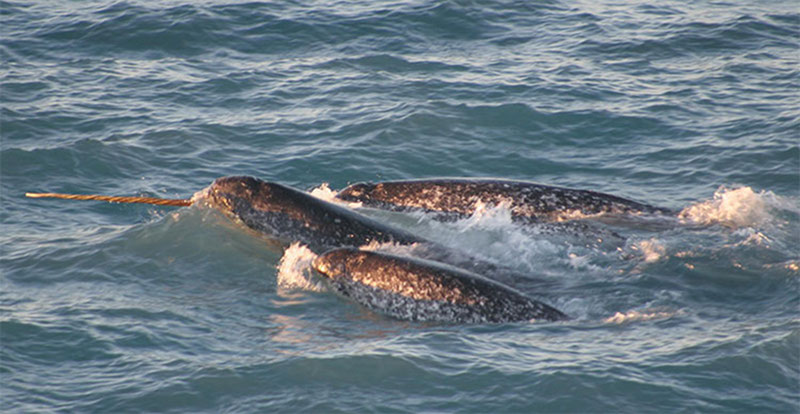What is a narwhal?
A narwhal is a medium-sized, toothed whale that is only found in Arctic waters.

Pod of narwhals, northern Canada, August 2005. Image courtesy of Kristin Laidre.Download image (jpg, 80 KB).
The narwhal is an odontocete or toothed whale, but is different from all other toothed whales in that it has no teeth in its mouth. Instead, male narwhals have a single long, straight tooth (or tusk) that protrudes two to three meters out of the upper left jaw. Females almost never have a tusk. The tooth grows in a counterclockwise spiral.
It is this tusk for which narwhals are best known. There are many legends about the tusk of the narwhal – it is essentially the origin of the myth of the unicorn as European whalers that were in the Arctic would catch narwhals and bring tusks back to Europe with great stories about what kind of animals the tusks were attached to. But in terms of the biology of the animal, the tusk is actually used for social structure, to establish dominance hierarchies and ranks of males within narwhal pods.
Narwhals have a black and white mottled skin pattern and are white underneath. This coloration contributed to their name. The old Norse prefix “Nar” means “corpse” and “hval” means “whale.” Thus, “corpse whale” refers to how their skin color resembles that of a drowned sailor. The scientific name for these whales, Monodon monoceros, means “one tooth, one horn.”
Not very much is known about narwhals, largely because they are difficult to study: They live in remote places, far from civilizations, in a habitat that is dark for half the year, covered in ice for half the year, and not easy to access.
We do know that narwhals have adapted to be one of the deepest diving marine mammals, capable diving to depths of more than 1,800 meters (5,905 feet) and able to spend a large amount of their time below 800 meters (2,625 feet). Not many animals can sustain such intense pressures below the surface of the water and stay under the water for so long.
The primary prey of narwhals include Greenland halibut, polar and Arctic cod, shrimp, and Gonatus squid. They change their diets seasonally, feeding intensely in the winter and eating little during the ice-free summer season. This feeding pattern is opposite of other sub-Arctic whale species, who tend to migrate south in the winter and feed in the summer. Scientists believe the narwhal’s intense winter feeding period may be an adaptation to relatively low productivity in the high Arctic summering areas or perhaps a behavioral trait to avoid competition with lower latitude whales feeding in summer.
Narwhals, like all marine mammals, are protected under the Marine Mammal Protection Act.